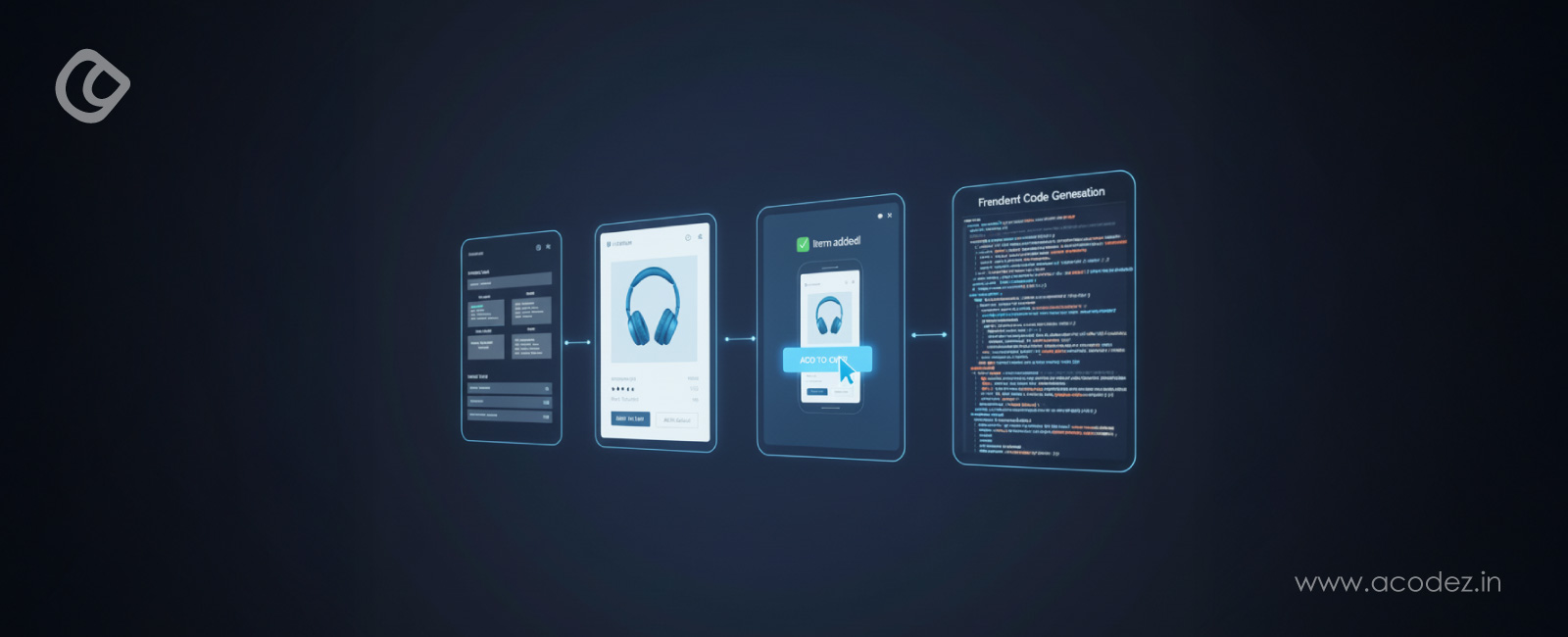If you’ve ever sat through a design hand-off where someone says,
“It’s all in Figma – should be simple,”.
And if your thought-bubble said “it won’t be”, this article is for you.
That phrase “should be simple” has probably cost the web industry more collective hours than any unsolved bug in history.
You open the Figma file. There are 47 layers named “Frame 1 Copy (Final)” and one mysterious component called “Rectangle 8.” The mockup looks gorgeous. Then you realize half the elements use absolute positioning, the text scales weirdly, and the color tokens don’t match your design system. You sigh, crack your knuckles, and start translating design idealism into browser reality.
Frontend development has always been that translation layer, part engineering, part archaeology. You don’t just build; you interpret, negotiate, and occasionally guess what the designer meant by “Make it pop.”
Somewhere between the design review and the pull request, you end up debugging a flexbox layout that looks fine everywhere except Safari, which is apparently still living in a parallel dimension where gap means “almost gap.”
And yet, despite all the friction, that loop, design to code to feedback to redesign, has defined modern web development. It’s productive in the way running a marathon in sandals is productive: yes, you get there eventually, but it might cost you your soul.
Now, that loop is starting to change.
AI is quietly stepping into the gap between pixels and production.
You can describe a layout in plain English, “a dashboard with a sidebar, dark mode, and cards that show user stats,” and an AI assistant will hand you working React components, complete with Tailwind classes, reasonable accessibility, and a deploy button for Vercel.
No plugin spaghetti. No pixel counting. No CSS purgatory.
It’s not replacing you. It’s finally helping you.
It does the boring parts, boilerplate, layout scaffolding, and the 600th instance of “center this div both vertically and horizontally,” so you can focus on the things that actually make your project worth shipping: the logic, the interactions, the small moments of delight that turn a page into a product.
Think of it as having a junior developer who never sleeps, never argues, and never asks why you use semicolons inconsistently. It works fast, doesn’t complain about meetings, and somehow knows what you meant even when you didn’t phrase it well, basically the coworker everyone wishes they had.
Of course, it’s still a machine. It won’t stop you from making bad design choices or naming your components “Thing.js.” But it will get you from “idea” to “running prototype” so fast that the design hand-off might soon become the design drive-by.
AI isn’t the future of frontend development; it’s just the first tool that actually seems to understand what frontend developers have been muttering about for years.
And that’s where things start to get interesting.
Because when you strip away the hype, AI in frontend design isn’t about robots writing your entire app or replacing human creativity. It’s about compression — squeezing the long, messy distance between an idea and a working prototype into something that fits between coffee breaks.
The first time you try it, it feels uncanny: you describe an app out loud, and code appears. Not perfect code, but good enough that you immediately start tinkering instead of setting up folders. For the first time, “build something real” and “describe what you want” mean almost the same thing.
The tools aren’t taking over your job; they’re just getting rid of the parts of it that never should’ve been there in the first place.
What “AI Frontend Design” Really Means
“AI frontend design” sounds like a buzzword, but it’s really about one thing: turning intent into implementation faster.
Under the hood, these tools combine three things:
- Natural language understanding: parsing prompts like “make it look like a dashboard” into design primitives (containers, cards, sidebars).
- Code synthesis: using large language models trained on frontend codebases to produce semantic HTML, JSX, and Tailwind classes.
- Layout reasoning: mapping human descriptions of space (“sidebar on the left”) into CSS constructs (flex, grid, justify-content, etc.).
That’s what makes tools like v0.dev or ChatGPT feel like “magic.”
You type something vague and end up with runnable JSX.
But the magic trick is built on millions of layout examples, the AI has literally seen thousands of “todo apps” and “dashboards” and learned what structure they usually have.
So when you describe “a todo app with a sidebar and filters,” it’s not guessing.
It’s pattern-matching like a senior developer who’s built this same thing twelve times before and finally just wrote a generator.
Step 1: Begin with a prompt instead of a pixel.
Most developers spend the first day of a new project arguing about setup, frameworks, linters, folders, names. AI skips all that. You start by telling it what you want to build.
Prompt: “A todo app with a sidebar for filters, a main task list, and dark mode.”
That one line gives you enough for a prototype: structure, color scheme, layout, even sample data.
If you want visuals first, Uizard lets you describe that same app and get a design mockup before you even touch code. It’s perfect for developers who hate opening Figma but still need something to show a stakeholder.
The point isn’t to skip design, it’s to remove the downtime between idea and visible result.When you can generate your first working build in five minutes, iteration becomes fun again.
Step 2: Generate React Components
Once you have the concept, AI scaffolds the code.
You: “Generate React components using Tailwind for styling. Make it responsive.”
AI: “Sure thing.”
The output is predictable but practical, divs in the right places, components split logically, Tailwind classes ready to tweak.
export default function TodoApp() {
return (
<div className=”flex min-h-screen bg-gray-900 text-white”>
<aside className=”w-64 bg-gray-800 p-4″>
<h2 className=”text-xl font-bold mb-4″>Filters</h2>
<ul>
<li>All</li>
<li>Completed</li>
<li>Pending</li>
</ul>
</aside>
<main className=”flex-1 p-6″>
<header className=”flex justify-between items-center mb-4″>
<h1 className=”text-2xl font-semibold”>My Tasks</h1>
<button className=”bg-blue-500 px-3 py-2 rounded”>+ Add Task</button>
</header>
</main>
</div>
);
}
If you’ve ever used a component library like Chakra UI or Material-UI, it’s the same feeling, except this one builds the layout you described, not one you chose from a grid of prebuilt templates.
When you use v0.dev, the process feels oddly like code pair programming with autocomplete on steroids. You describe the structure, it writes JSX; you refine, it rewrites; you copy-paste, and somehow you’ve already got a working layout.
Step 3: Add State and Logic
AI is surprisingly good at wiring up logic because it already understands React patterns.
You can literally type: “Add useState to manage a list of tasks and a function to add new ones.” And it generates:
const [tasks, setTasks] = useState([“Learn AI”, “Build portfolio”]);
function addTask(task) {
setTasks([…tasks, task]);
}
No imports forgotten, no syntax errors. It just… works.
You can extend it further: “Add filtering by completed or pending tasks using buttons.”
It will create conditional rendering blocks. You can even ask it to persist to localStorage, and it will do that too.
This is where developers start realizing AI isn’t stealing their job — it’s just automating the part that never made them feel smart anyway.
Step 4: Polish and Style
Once the layout works, you’ll want to make it presentable. AI styling is like a polite intern with decent taste. You tell it: “Improve spacing, typography, and color contrast. Add hover effects and focus states.” And it quietly adjusts margins, replaces clunky padding with consistent spacing, and adds ARIA attributes for accessibility. It’s not a replacement for human judgment, it just saves you from another half hour of “is it gap-2 or gap-3?” decisions.
You can even give design direction: “Use a soft blue-gray palette, rounded corners, and card shadows.” And it will actually apply those classes correctly. It’s weirdly satisfying, like watching a linter beautify your entire app.
Step 5: Deploy Before the Meeting Ends
This is where the workflow feels truly 2025. You can ask AI: “Deploy this project to Vercel.” And it generates the config, sets up the project folder, and gives you deployment commands.
git init
git add.
git commit -m “Initial commit”
npx vercel deploy
You press enter. Your prototype is live before your stand-up ends. That used to take hours of setup and DevOps side quests. Now it’s a line of text and some trust in your AI sidekick.
The New Frontend Workflow
For developers used to the traditional way of building interfaces, here’s the real difference:
- Design Phase: You don’t wait for mockups. You describe what you want, and AI gives you something tangible to iterate on.
- Build Phase: No more blank files. You get structured components instantly, with Tailwind classes and responsive layout baked in.
- Logic Phase: Adding interactivity is now prompt-driven. “Add state,” “Add form validation,” “Handle error state,” all work.
- Styling Phase: AI polishes spacing, contrast, and hierarchy, freeing you from CSS micro-tweaks.
- Deployment Phase: It can generate deployment configs for Vercel or Netlify without a single tutorial search.
In other words, you spend less time building scaffolding and more time solving actual problems.
Best Practices (a.k.a. How to Use AI Without Regret)
- Read the Code: AI doesn’t “know” what’s right; it knows what’s statistically common. Check for logic quirks. Beware of shipping AI “hallucinations”,
- Define Design Tokens Early: Give it your color, typography, and spacing rules up front. Otherwise, it invents some “grayish blue” shade you’ll hate later.
- Prompt Like You Mean It: “Make it responsive” and “Make it mobile-friendly with a hamburger menu” are not the same. Clarity matters.
- Accessibility Isn’t Optional: Ask it to handle focus states, ARIA attributes, and keyboard navigation. You’ll thank yourself.
- Don’t Debug by Hand: If it’s wrong, don’t tweak the CSS, re-prompt with better instructions.
Good AI workflows look less like debugging and more like a conversation.
What AI Still Can’t Do (Yet)
AI is fast, but it’s not omniscient. There are limits.
- It doesn’t know your product’s intent. It can generate a layout, but not your business logic or UX priorities. You still have to think.
- It struggles with complex component states. Multi-step modals or real-time interactions still require you.
- It has no sense of taste. It can mimic design trends, but it doesn’t know why one design feels better than another.
- It can’t debug your build pipeline. When you hit an obscure Vite error, you’re on your own.
AI is great at syntax and structure, but meaning is still your job.It’s not replacing creativity. it’s just giving you back the hours you used to spend fiddling with margins.
Useful Tools (and How to Actually Use Them)
Vercel v0.dev
What it is: A text-to-React tool from Vercel that generates working JSX + Tailwind layouts.
Free tier: Yes, limited.
How to use:
- Log in at v0.dev.
- Prompt: “Generate a responsive dashboard with sidebar, header, and card grid in dark mode.”
- Tweak structure, download JSX, or deploy instantly to Vercel.
Pro tip: Follow up with “Make it mobile responsive” or “Add dark/light toggle.”
Uizard.io
What it is: An AI-powered UI mockup tool that turns prompts or screenshots into design wireframes.
Free tier: Yes (limited screens).
Paid: $12/month for Pro.
How to use:
- Start a new project with “Autodesigner.”
- Prompt: “Web app for a habit tracker with daily stats and minimalist style.”
- Get clickable mockups to share or reference in code.
Locofy.ai
What it is: Converts Figma designs into React or Next.js code.
Free trial: Yes. Paid via usage tokens.
How to use:
- Install the Locofy Figma plugin.
- Label your components properly.
- Export as React + Tailwind.
Tip: Clean layer naming = clean code generation.
Cursor.sh
What it is: An AI-first IDE that can refactor, debug, and comment your code on request.
Free tier: Yes. Paid tiers: $20–$40/month.
How to use:
- Load your React project in Cursor.
- Hit Cmd+K and type: “Add a debounce to this search input.”
- Accept, test, repeat.
Why it’s great: It’s pair programming without the awkward small talk.
Putting It All Together
Here’s what a modern AI-powered workflow looks like for a React developer:
- Describe your app idea in v0.dev: “Dashboard with sidebar, chart grid, and dark mode.”
- Use Uizard to generate a visual reference for stakeholder approval.
- Export to code using Locofy.
- Open in Cursor, prompt for logic (“Fetch data with useEffect, add loading state”).
- Test locally, deploy to Vercel, and post the preview link in Slack before anyone asks for it.
The Bigger Picture
If you zoom out, this shift is less about automation and more about compression. The distance between an idea and a live app has collapsed. What used to take a sprint now takes a morning.
The developer’s role isn’t shrinking, it’s evolving. You’re no longer just a code generator. You’re a creative director for machines that code for you.
Frontend work is becoming what it was always meant to be: the art of shaping experiences, not fighting layouts.
Final Thoughts
AI isn’t replacing frontend developers. It’s finally helping them. The job was never “type faster.” It was “build smarter.”
Now, you can skip the boilerplate, automate the boring bits, and spend more time on features that matter.
You still own the app.
You just have a faster way to get there now.
Acodez is a renowned web development company india. We offer all kinds of web design and Mobile app development services to our clients. using the latest technologies. We are also a leading digital marketing agency in India, providing SEO, SMM, SEM, and Inbound marketing services at affordable prices. For further information, please contact us.
FAQ Questions
1: Can AI really convert Figma designs to production-ready code?
Answer: Yes, but with caveats. Tools like v0.dev, Locofy, and Builder.io can convert Figma designs to React/Tailwind code in minutes. However, Reddit developers report that while these tools work well for simple layouts, they often “shit the bed” on complex requests.
2: Which AI tool is actually best for frontend developers Claude, ChatGPT, Copilot, or v0?
Answer: According to Reddit discussions, Claude AI is currently considered the best for programming tasks, particularly for complex logic and refactoring. However, v0.dev excels at UI generation and contextual understanding, while GitHub Copilot is ideal for inline code completion.
3: Why does AI-generated code sometimes have so many bugs?
Answer: AI models predict the “most likely” code based on training data, not necessarily the “most correct” code. Research shows AI assistants replicate patterns, including insecure or buggy patterns, from public repositories. They lack understanding of your specific application context, edge cases, and business logic. Additionally, AI optimizes for “working code” not “maintainable code”, often producing syntactically correct but logically flawed solutions. This is why human code review remains essential.
Looking for a good team
for your next project?
Contact us and we'll give you a preliminary free consultation
on the web & mobile strategy that'd suit your needs best.






